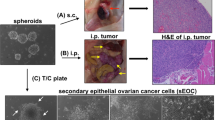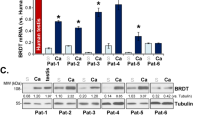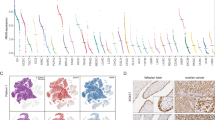Abstract
To understand the molecular changes during ovarian cancer development, we profiled differentially expressed genes in five paired normal and cancerous ovarian tissues. Among the genes that showed differential expression, thymosin β-10 expression was decreased in four of five cancer tissues. The decreased level of expression was confirmed by Northern. To investigate the gene's functional role in ovarian cancers, we constructed an adenovirus vector expressing thymosin β-10 and used it to infect ovarian cancer cell lines PA-I and SKOV3. The infected cells showed disrupted F-actin stress fibers, markedly decreased cell growth, and a high rate of apoptosis. Thus, because loss of thymosin β-10 expression may contribute to the development of a subset of ovarian cancers, restoration of thymosin β-10 expression may be a new strategy for ovarian cancer treatment.
This is a preview of subscription content, access via your institution
Access options
Subscribe to this journal
Receive 50 print issues and online access
$259.00 per year
only $5.18 per issue
Buy this article
- Purchase on Springer Link
- Instant access to full article PDF
Prices may be subject to local taxes which are calculated during checkout






Similar content being viewed by others
Change history
13 August 2002
A Correction to this paper has been published: https://doi.org/10.1038/sj.onc.1205714
References
Bao L, Loda M, Janmey PA, Stewart R, Anand-Apte B, Zetter BR . 1996 Nat. Med. 2: 1322–1328
Caduff RF, Svoboda-Newman SM, Ferguson AW, Jonston CM, Frank TS . 1999 Am. J. Surg. Pathol. 23: 323–328
Carpintero P, Franco del Amo F, Anadon R, Gomez-Marquez J . 1996 FEBS Lett. 394: 103–106
DeRisi J, Penland L, Brown PO, Bittner ML, Meltzer PS, Ray M, Chen Y, Su YA, Trent JM . 1996 Nat. Genet. 14: 457–460
Eadie JS, Kim SW, Allen PG, Hutchinson LM, Kantor JD, Zetter BR . 2000 J. Cell. Biochem. 77: 277–287
Fuller GN, Rhee CH, Hess KR, Caskey LS, Wang R, Bruner JM, Alfred Yung WK, Zhang W . 1999 Cancer Res. 59: 4228–4232
Gold JS, Bao L, Ghoussoub RA, Zetter BR, Rimm DL . 1997 Mod. Pathol. 10: 1106–1112
Hall AK, Hempstead J, Morgan JI . 1990 Mol. Brain Res. 8: 129–135
Hall AK, Aten R, Behrman HR . 1991 Mol. Cell. Endocrinol. 79: 37–41
Hall AK . 1994a Ren Fail 16: 243–254
Hall AK . 1994b Med. Hypotheses. 43: 125–131
Hall AK . 1995 Cell. Mol. Biol. Res. 41: 167–180
Henriksen R, Strang P, Wilander E, Bδckstrωm T, Tribukait B, Oberg K . 1994 Gynecol. Oncol. 53: 301–306
Hough CD, Sherman-Baust CA, Pizer ES, Montz FJ, Im DD, Rosenshein NB, Cho KR, Riggins GJ, Morin PJ . 2000 Cancer Res. 60: 6281–6287
Huang P, Feng L, Oldham EA, Keating MJ, Plunkett W . 2000 Nature 407: 390–395
Iguchi K, Hamatake M, Ishida R, Usami Y, Adachi T, Yamamoto H, Koshida K, Uchibayashi T, Hirano K . 1998 Eur. J. Biochem. 253: 766–770
Marian AJW, Goos NPV, Dirk JR, Henri PJB . 1993 Int. J. Cancer 53: 278–284
Marx D, Binder C, Meden H, Lenthe T, Ziemek T, Hiddemann T, Kuhn W, Schauer A . 1997 Anticancer Res. 17: 2233–2240
Meden H, Marx D, Raab T, Krohn M, Schauer A, Kuhn W . 1995 J. Obstet. Gynaecol. 21: 167–178
Morita K, Ono Y, Fukui H, Tomita S, Ueda Y, Terano A, Fujimori T . 2000 Pathol Int. 50: 219–223
Nachmias VT . 1993 Curr. Opin. Cell. Biol. 5: 56–62
NIH Consensus Statement . 1994 12: 1–30
Pollard TD, Cooper JA . 1986 Ann. Rev. Biochem. 55: 987–1035
Rauh-Adelmann C, Lau KM, Sabeti N, Long JP, Mok SC, Ho SM . 2000 Mol. Carcinog. 28: 236–246
Santelli G, Califano D, Chiappetta G, Vento MT, Bartoli PC, Zullo F, Trapasso F, Viglietto G, Fusco A . 1999 Am. J. Pathol. 155: 799–804
Velculescu VE, Zhang L, Vogelstein B, Kinzler KW . 1995 Science 170: 484–487
Verghese-Nikolakaki S, Apostolikas N, Livaniou E, Ithakissios DS, Evangelatos GP . 1996 Br. J. Cancer 74: 1441–1444
Yamamoto T, Gotoh M, Kitajima M, Hirohashi S . 1993 Biochem. Biophys. Res. Commun. 193: 706–710
Yu FX, Lin SC, Morrison-Bogorad M, Atkinson MA, Yin HL . 1993 J. Biol. Chem. 268: 502–509
Yu FX, Lin SC, Morrison-Bogorad M, Yin HL . 1994 Cell. Motil. Cytoskeleton. 27: 13–25
Zhang L, Zhou W, Velculescu VE, Kern SE, Hruban RH, Hamilton SR, Vogelstein B, Kinzler KW . 1997 Science 276: 1268–1272
Acknowledgements
This work was partially supported by G7 and SRC funds of the Korea Science and Engineering Foundation and by Texas Tobacco Settlement Funds appropriated by the Texas Legislature to The University of Texas M. D. Anderson Cancer Center.
Author information
Authors and Affiliations
Corresponding author
Rights and permissions
About this article
Cite this article
Lee, SH., Zhang, W., Choi, JJ. et al. Overexpression of the thymosin β-10 gene in human ovarian cancer cells disrupts F-actin stress fiber and leads to apoptosis. Oncogene 20, 6700–6706 (2001). https://doi.org/10.1038/sj.onc.1204683
Received:
Revised:
Accepted:
Published:
Issue Date:
DOI: https://doi.org/10.1038/sj.onc.1204683
Keywords
This article is cited by
-
Thymosin β10 promotes tumor-associated macrophages M2 conversion and proliferation via the PI3K/Akt pathway in lung adenocarcinoma
Respiratory Research (2020)
-
Recombinant Expression and Bioactivity Characterization of TAT-Fused Thymosin β10
The Protein Journal (2019)
-
Role of thymosin beta 4 in hair growth
Molecular Genetics and Genomics (2016)
-
High expression of thymosin beta 10 predicts poor prognosis for hepatocellular carcinoma after hepatectomy
World Journal of Surgical Oncology (2014)
-
Suppression of thymosin β10 increases cell migration and metastasis of cholangiocarcinoma
BMC Cancer (2013)



